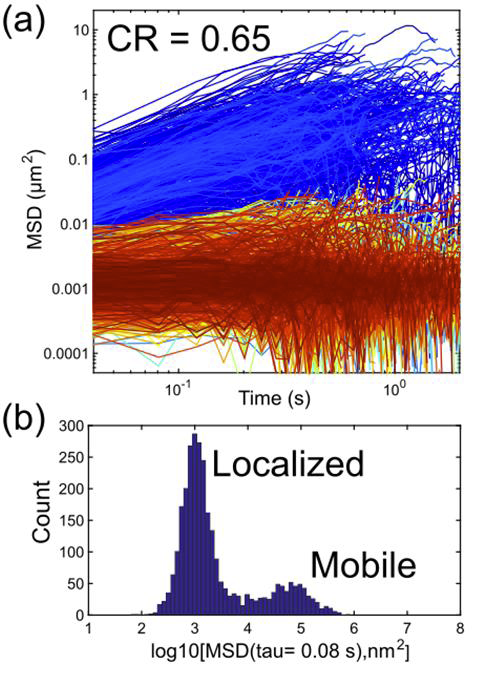Reports: ND754028-ND7: Nanosphere and Nanorod Diffusion in Polymer Melts
Russell J. Composto, University of Pennsylvania
ACS Update
Investigating the Diffusion Behavior of Nanoparticles in Polymer Networks: Melts, Gels, and Cells
Dynamic properties play an important role in designing functional polymer nanocomposites, impacting molecular transport, and separation kinetics. When nanoparticle (NP) size is comparable to polymer chain size, novel dynamics have been predicted. In this series of studies, NP dynamics were characterized in polymer melts, gels, and the cell cytoplasm to understand how polymer parameters effect diffusion. In each of these systems, confinement due to network chains impacted the diffusion properties of the NPs.
During the 2016-2017 time extension, we have extended our studies of NP diffusion into polyacrylamide gels by introducing collapse using a poor solvent, namely acetone.
Diffusion of Nanoparticles in Swollen Polymer Gels (advances during extension)
The incorporation of nanoparticles (NPs) to form hybrid polymer gels is integral to maintaining the desirable qualities of gels, such as high swelling ratios, flexibility, and light weight, while adding functionality. To determine systematic relationships between NP mobility and polymer gel properties, a model system of polyacrylamide gels (PAGs) were chosen due to the ability to modify the network by changing crosslinking concentration as well as a poor solvent. Results reported in the prior report (Oct 2016) described the effect of cross-linking whereas this report describes the effect of poor solvents on diffusion.
NP diffusion was also studied in PAGs collapsed by adding acetone to a water swollen PAG. The addition of a poor solvent resulted in an increase in the percentage of localized NPs and a slowing down of the mobile NPs. For PAGs with 10 vol. % acetone having CR = 0.65, NPs exhibited both mobile and localized behavior as shown in Figure 1. The MSD curves in Figure 1a show that mobile NPs have lower MSDs compared to the mobile NPs in water swollen PAGs with the same crosslinker content. Figure 1b shows a histogram of the MSD values at 0.08 s with the MSD values for localized NPs centered at 103 nm2 (32 nm)2, similar to localized NPs in the water swollen gels. In Figure 1b, the MSD values of mobile NPs at 0.08s are centered at approximately 105 nm2 (320 nm)2, an order of magnitude lower than the MSD values of the crosslinked PAG with CR = 0.4. While localized NPs were the minority in water swollen PAG with CR = 0.4, mobile NPs only accounted for 20% population in the collapsed PAG with CR = 0.65 (Figure 1b). These trends persisted in all acetone collapsed PAGs, with mobile NPs making up only 20 to 25 of the population. The slowing down of the mobile NPs and increase in localized population cannot be attributed solely to an increase in CR but rather reflects differences between the local environment in the crosslinked and acetone collapsed PAGs.
The diffusion of NPs within PAGs was studied as a function of network confinement. By increasing crosslinker concentration or adding acetone to collapse PAG, the average mesh size was reduced to produce confinement ratios less than and greater than 1. In both PAGs, there was a corresponding decrease in NP mobility, yet NP diffusion was retained even when the NP was nearly 4x larger than the average mesh. NP mobility could be separated into localized and mobile populations. The mobile NPs displayed either intermittent localization through diffusive motion interspersed with random localization or continual diffusive motion. Diffusion coefficients decreased with confinement ratio, although the NP diffusion in the collapsed gels was slower than diffusion in the crosslinked gels when compared at a constant confinement ratio. This difference was attributed to dynamic heterogeneity, which is supported by analysis of the displacement distributions and non-Gaussian parameters. Displacement distributions showed exponential tails that decreased in length and likelihood as confinement increased. This reduction occurred more rapidly in the collapsed PAGs than in the crosslinked PAGs, which is consistent with the greater dynamic heterogeneity observed in the collapsed PAGs. These results suggest that the local structure of the collapsed PAGs is quite heterogeneous, resulting in dense regions with a small mesh size that localizes NPs and/or act as obstacles for NP mobility. Ultimately, by understanding how the macro and nanoscopic structure of polymer gels affects NP dynamics, the performance of membranes, separators, and drug delivery gels can be tailored with unprecedented control.
Figure 1: (a) MSD where blue curves represent mobile NPs and red curves localized NPs in an acetone collapsed gel with average mesh size 32 nm. (b) MSD values at 0.08 s showing localized NPs centered around 103 nm2 (or ~ 30 nm)2) and mobile NPs around ~105 nm2 (or ~320 nm)2). (from doi:10.1063/1.4978054)












